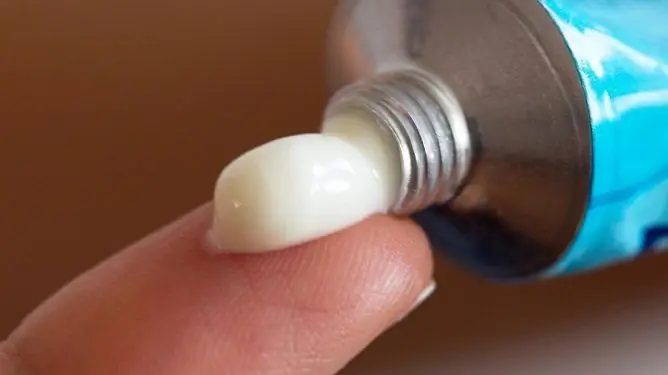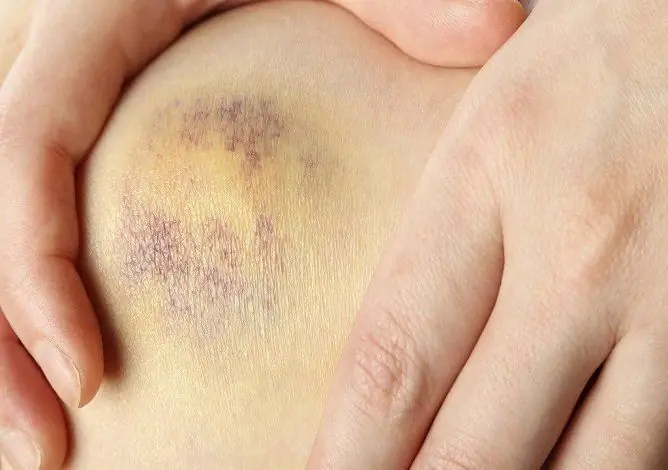- Author Rachel Wainwright [email protected].
- Public 2024-01-15 19:51.
- Last modified 2025-11-02 20:14.
Armpits sweat a lot: what to do with primary and secondary hyperhidrosis
The content of the article:
- Features of the development of hyperhidrosis in men and women
-
Causes of increased sweating
- Primary hyperhidrosis
- Secondary hyperhidrosis
-
How to get rid of underarm sweating
- Diagnostics
- Conservative treatment
- Personal hygiene rules
- Video
Armpits sweat a lot - what to do? This question is of interest to everyone who is faced with axillary hyperhidrosis. With intense physical exertion, an increase in ambient temperature, psycho-emotional stress and the consumption of a large volume of water, excessive sweating is a normal reaction of the body.

Excessive sweating in the armpit area can occur in both men and women
A deviation from the norm is considered to be axillary hyperhidrosis, which occurs in the absence of provoking physical factors and at rest. Any type of disease affects a person's social adaptation and worsens his quality of life.
In general, sweating is a physiological process that protects the body from overheating. The watery secretion secreted by the sweat glands protrudes onto the surface of the body and then evaporates, thereby cooling the skin and lowering its temperature.
Pathological violations of this process are expressed both in the excessive production of secretions and in the appearance of a sharp unpleasant odor. Both of these symptoms cause severe psychological discomfort to the patient and cause him to experience constant stress, which further provokes the production of sweat.
Features of the development of hyperhidrosis in men and women
In women, this disease occurs more often than in men, which is explained by their increased emotionality and changes in hormonal levels that occur at different periods of life. Also, girls and boys often face the problem of excessive sweating, since the maximum activity of the sebaceous and sweat glands occurs during the transition period.

In women, pathology is more common than in men
Most rarely, pathology is observed in persons over 50 years old, since at this age the activity of the sweat glands decreases, and the production of sweat is significantly reduced.
Causes of increased sweating
Primary hyperhidrosis
When increased sweating in the armpit area is observed for no apparent reason - thermoregulatory stimuli or the presence of concomitant pathologies, we are talking about primary hyperhidrosis.
The most common persistent armpits sweat in adolescents during puberty. The appearance of hyperhidrosis is associated with hormonal disorders characteristic of this age. Also, this form can develop due to a genetic predisposition, the presence of a large number of sweat glands, their excessive innervation or too wide ducts.

Increased sweating can be noted against the background of psycho-emotional stress
The diet, as well as excessive excitement, emotionality, shyness and other psychological factors, can serve the development of pathology.
Secondary hyperhidrosis
Secondary hyperhidrosis appears due to the disorders existing in the body and acts as one of their manifestations. The pathologies leading to its occurrence include:
- thyrotoxicosis: excessive activity of the thyroid gland entails a violation of the hormonal balance in the body, which affects the functioning of the sweat glands;
- vegetative-vascular dystonia: can lead to malfunctions of the thermoregulation system;
- hypoglycemia, diabetes mellitus: lead to disorders of the peripheral nervous system, which regulates the activity of the sweat glands;
- climacteric syndrome: often accompanied by hot flashes and intense sweating;
- tuberculosis and other pathologies of an infectious nature: they affect the center of thermoregulation and cause a significant increase in body temperature, which is accompanied by excessive sweating;
- septicemia: due to blood poisoning, fever develops and the release of watery secretions increases;
- pheochromocytoma: the presence of a hormonally active tumor in the body can cause a sharp increase in blood pressure, body temperature and sweating;
- Parkinson's disease, syphilis, stroke: diseases that affect the functioning of the central and peripheral nervous system can lead to increased production of sweat both in the armpit and other parts of the body.
Axillary hyperhidrosis can also be a side effect of certain medications. Treatment with antidepressants, Insulin, Aspirin, some pain relievers, antiemetic and cholinergic drugs can serve as its appearance.
How to get rid of underarm sweating
Usually, patients seek medical help from the moment when excessive sweating begins to be accompanied by an unpleasant odor or dermatological pathologies of the armpits (for example, hydradenitis). However, it is important to look for the cause of hyperhidrosis at the very beginning of the onset of its symptoms.
Diagnostics
The diagnosis of the disease is carried out by a dermatologist or therapist. In the course of a detailed interview, study of the history and physical examination, the doctor suggests the possible causes of its appearance.

To diagnose and prescribe therapy, you need to contact a therapist or dermatologist
Laboratory examinations that are carried out to clarify the diagnosis include:
- blood test: general and biochemical, for thyroid hormones, syphilis, glucose levels, hepatitis and HIV;
- general urine analysis;
- fluorography.
The quantitative and qualitative assessment of sweat is carried out by conducting research such as:
- Minor's test: allows you to establish the boundaries of the area with excessive sweating. The study is carried out by applying starch and iodine solution to thoroughly dried skin. During the reaction, the areas with overactive glands will turn black and blue;
- gravimetric analysis: a sheet of filtered paper is weighed and then applied to the armpits and weighed again. By means of such manipulation, the amount of sweat secreted in 1 minute is established and the severity of the disease is assessed;
- chromatographic analysis: allows you to study the chemical composition of sweat to select the most optimal therapy and diet.
Conservative treatment
The relief of secondary hyperhidrosis is achieved by therapy of the underlying disease that caused its appearance.

The effect of botox injections usually lasts for six months
Depending on the severity of the pathology, the following can be used:
| Treatment method | Characteristic |
| Drug therapy | Given the contraindications and possible side effects, the doctor may prescribe belladonna-based drugs, tranquilizers or sedatives (herbal sedatives, drugs containing valerian and motherwort). They reduce the excitability of the nervous system, help cope with stress and reduce the secretion of sweat glands. |
| Medical antiperspirants | These deodorants contain salicylic acid, zinc salts, formaldehyde, aluminum, triclosan and other chemical compounds. They narrow or almost completely block the excretory ducts of the sweat glands, block the removal of sweat to the outside and remove odor |
| Psychotherapy | If the cause of hyperhidrosis lies in psychological problems, psychotherapy sessions help keep the patient's fears and strong experiences under control, which leads to a decrease in the manifestations of the disease. |
| Botulinum toxin injections | Subcutaneous Botox injections block the nerve endings that supply the sweat glands, which significantly reduces sweating for an average of 6 months. However, this method of treatment has contraindications and is expensive. |
| Physiotherapy methods | For treatment, hydrotherapy is used (Charcot shower, coniferous-salt therapeutic baths), electrosleep, medicinal electrophoresis |
Personal hygiene rules
An important condition for effectively eliminating the manifestations of hyperhidrosis is careful adherence to the rules of personal hygiene. The patient needs to take a shower every day and several times a day to wipe the body with a towel dipped in a water-vinegar solution.
Traditional medicine recommends taking a bath with the addition of oak bark or chamomile infusion. Of no small importance is the exclusion of wearing underwear and clothing made of synthetic fabrics.
A complex of conservative methods of therapy in combination with spa treatment allows achieving a longer therapeutic effect. However, it should be borne in mind that in the case of primary hyperhidrosis, these methods stop its manifestations temporarily, and it can be cured forever only through surgical intervention.
Video
We offer for viewing a video on the topic of the article.

Anna Kozlova Medical journalist About the author
Education: Rostov State Medical University, specialty "General Medicine".
Found a mistake in the text? Select it and press Ctrl + Enter.






